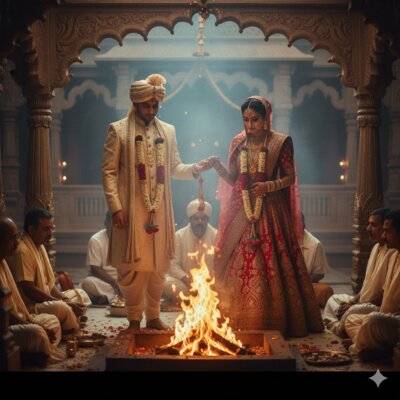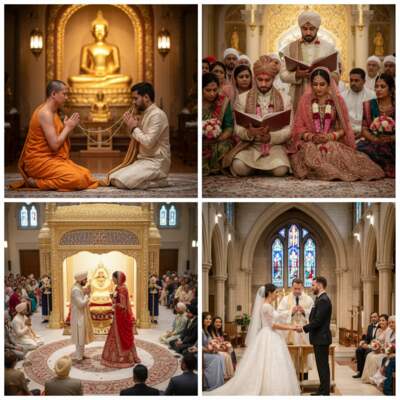Sacred Beginnings: Before You Say "I Do"
The "I Do" Moment: 200+ Ways to Tie the Knot

The ceremony-the moment everything changes. But how that moment unfolds depends entirely on where you are in the world.
In a Jewish wedding, the groom stomps on a glass wrapped in cloth, shattering it while guests shout “Mazel tov!” The breaking symbolizes the destruction of the Temple in Jerusalem, a moment of remembrance even in joy. Some say it’s also a reminder that marriage, like the glass, is fragile-handle with care.
In Scotland, couples practice handfasting-their hands are literally bound together with ribbons or cords in a figure-eight pattern. It’s where the phrase “tying the knot” comes from. The binding is temporary, but the symbolism is eternal: two lives, one path.
Mexican couples experience El Lazo-godparents drape a large decorative rope or rosary in a figure-eight around the couple’s shoulders, symbolizing their eternal bond and unity. The figure-eight represents infinity, and the couple wears it throughout the ceremony.
In Japan, the couple shares sake three times from three different-sized cups-san-san-kudo, “three-three-nine-times.” The ritual bonds not just the couple, but their families, in an act of profound respect and unity.
Hindu couples take seven steps together around a sacred fire-Saptapadi-each step representing a vow: from nourishment and strength to loyalty and devotion. By the seventh step, they are married in the eyes of the gods.
African-American couples might jump the broom, a tradition born from slavery when legal marriage was forbidden. Today it’s a powerful symbol of sweeping away the past and leaping into the future together.
From Catholic masses to Buddhist chants, from outdoor Celtic ceremonies to elaborate Orthodox rituals, there are as many ways to say “I do” as there are cultures on Earth. Each ceremony tells a story-of faith, family, history, and hope.
How will you say forever?
Let the Feast Begin: When Cultures Party

If the ceremony is sacred, the reception is where sacred meets spectacular chaos.
Italian weddings are legendary marathons-expect 12+ courses, multiple toasts (each requiring a speech), and dancing until dawn. And just when you think it’s over, someone suggests breakfast. The party doesn’t end; it just changes venues.
Chinese banquets feature 8, 9, or 10 courses (never 4-that number sounds like “death”), with each dish carrying symbolic meaning. Shark fin soup for prosperity, whole fish for abundance, sweet lotus seed soup for fertility. Miss a course, miss a blessing.
Greek weddings have the money dance: guests literally pin cash to the bride and groom while they dance. It’s practical (honeymoon funding), celebratory, and surprisingly athletic when your dress is covered in bills.
At a Scottish reception, you’ll witness the ceilidh-traditional group dances that range from elegant to gloriously messy. Don’t know the steps? Doesn’t matter. You’ll be swept up in it anyway, probably slightly drunk on whisky, definitely having the time of your life.
Jewish weddings feature the hora-a high-energy circle dance where the bride and groom are hoisted into the air on chairs while holding a napkin between them. It looks terrifying. It is terrifying. It’s also transcendent.
American receptions might include the Electric Slide, the Cupid Shuffle, or an awkward moment when the DJ plays “YMCA” and you question all your life choices. But hey, open bar.
The reception is where formality relaxes, where distant relatives become dance partners, where kids steal cake, and where a celebration becomes a memory. It’s controlled chaos at its finest-and every culture does chaos a little differently.
How will you celebrate?
Dressed for Forever: What the World Wears

White wedding dress? That’s just one option in a world of stunning possibilities.
In India, brides wear red and gold saris or lehengas, intricately embroidered and often weighing 10+ pounds. White is for funerals; red represents prosperity, fertility, and auspiciousness. The more elaborate the outfit, the more blessed the union.
Japanese brides might wear a shiromuku (pure white kimono) for the ceremony, then change into a colorful uchikake (ornate outer robe) for the reception. Some brides change outfits three or four times during the celebration-each representing a different stage of the journey.
Chinese brides traditionally wear red qipao or cheongsam dresses embroidered with phoenixes and dragons-symbols of the bride and groom. Modern couples might blend traditions: white dress for the ceremony, red qipao for the tea ceremony.
Scottish grooms wear kilts in their clan tartan, complete with sporran, sgian-dubh (a small knife tucked in the sock), and often a dramatic entrance with bagpipes. The bride might incorporate tartan into her accessories or dress.
In Nigeria, weddings are fashion shows. Couples (and often all guests) wear elaborate aso-ebi-matching fabric outfits in bold colors with intricate gele (head wraps) that qualify as architectural achievements.
Western brides championed white after Queen Victoria wore it in 1840, making it a symbol of purity and style. Now it’s tradition, but even Western weddings are embracing color-blush, champagne, even red.
From ornate to minimalist, traditional to avant-garde, wedding attire tells the world: “This is who we are, where we come from, and how we choose to step into our future.”
What will you wear when you say “I do”?
The Language of Gifts: Cash, Cows, or Kitchenware?

Gift-giving reveals fascinating cultural values-and occasional awkward moments.
Greek guests bring odd-numbered amounts of money because even numbers are for funerals. So you’ll see gifts of €101, €151, €301-never a round number. It’s math with superstition.
Chinese guests give money in red envelopes (hongbao), with amounts carefully chosen: 8 is lucky (sounds like “prosperity”), 4 is avoided (sounds like “death”), and the amount should reflect your relationship to the couple. Close family? Think thousands. Distant coworker? Hundreds. There’s a whole etiquette.
Filipino weddings feature money pinning-guests literally pin bills to the bride and groom’s clothing while they dance. By the end, they look like they robbed a bank. It’s festive laundering.
Americans create gift registries-essentially wish lists at stores. Guests buy the couple a toaster, some towels, maybe a fancy blender. It’s practical, efficient, and removes all mystery. Some find it charming; others find it transactional. Both are right.
In some East African cultures, traditional gifts include livestock-cows, goats, chickens. It’s not symbolic; it’s actual wealth. Your value as a couple is literally measured in livestock.
Indian weddings involve elaborate gift exchanges between families-jewelry, clothing, sweets, household items. The bride’s family traditionally bears significant expenses, though modern couples are shifting toward more balanced arrangements.
Japanese couples might give hikidemono-return gifts to guests that often exceed the value of what was given. It’s reciprocity elevated to an art form.
Whether it’s cash, cows, or a Kitchen-Aid mixer, gifts represent community support, practical help, and the acknowledgment that two lives merging need resources. The form changes, but the meaning remains: “We’re investing in your future together.”
What’s your gift philosophy?
After the Party: Where Love Goes Next

The wedding ends. The marriage begins. But some cultures don’t let go of celebration quite so easily.
Italian newlyweds might face la Scampanata-friends and family showing up at midnight banging pots and pans until the couple emerges and provides food and drinks. Think caroling, but louder and more demanding.
In France, there’s charivari-guests gather outside the couple’s window on the wedding night making noise until the couple appears with champagne. Privacy? Not on your wedding night.
The honeymoon itself is a relatively modern Western invention, but the concept of seclusion after marriage appears across cultures. In some Hindu traditions, the couple returns to the bride’s parents’ home for a period before establishing their own household.
Japanese couples have a year of “firsts”-first New Year’s as a married couple, first shrine visit, first Obon (ancestor festival). Each milestone celebrated with family, each one cementing the marriage in the social fabric.
Some cultures practice post-wedding gift exchanges that continue for months-an ongoing negotiation and relationship-building between families.
Modern honeymoons range from beach resorts to adventure travel, from staycations to months-long trips. But the goal remains the same: transition from wedding mode to married life, hopefully with less stress and more romance.
The party might be over, but the celebration-if you do it right-never really ends. It just becomes daily life, with occasional cake.
Where will your love go next?